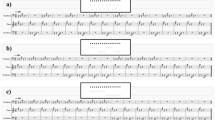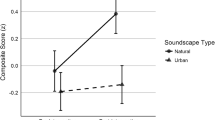Abstract
Musicians sometimes report twitching in their fingers or hands while listening to music. This anecdote could be indicative of a tendency for auditory-motor co-representation in musicians. Here, we describe two studies showing that pianists (Experiment 1), but not novices (Experiment 2) automatically generate spatial representations that correspond to learned musical actions while listening to music. Participants made one-handed movements to the left or right from a central location in response to visual stimuli while listening to task-irrelevant auditory stimuli, which were scales played on a piano. These task-irrelevant scales were either ascending (compatible with rightward movements) or descending (compatible with leftward movements). Pianists were faster to respond when the scale direction was compatible with the direction of response movement, whereas novices’ movements were unaffected by the scale. These results are in agreement with existing research on action–effect coupling in musicians, which draw heavily on common coding theory. In addition, these results show how intricate auditory stimuli (ascending or descending scales) evoke coarse, domain-general spatial representations.



Similar content being viewed by others
Notes
Note that although a descending (ascending) scale must be played with leftward (rightward) hand-finger movements, the arm movements that precedes the scale is independent; a pianist might reach rightward to initiate a descending scale, which would be performed with leftward movements.
References
Altenmüller, E., & Schneider, S. (2009). Planning and performance. In S. Hallam, I. Cross & M. Thaut (Eds.), The Oxford Handbooks of Music Psychology (Ch. 31). Oxford, England: Oxford University Press.
Bangert, M., & Altenmuller, E. O. (2003). Mapping perception to action in piano practice: a longitudinal DC-EEG study. BMC Neuroscience, 4, 26.
Calvo-Merino, B., Glaser, D. E., Grezes, J., Passingham, R. E., & Haggard, P. (2005). Action observation and acquired motor skills: an fMRI study with expert dancers. Cerebral Cortex, 15, 1243–1249.
Cross, E, Hamilton, A F deC, & Grafton, S T (2006). Building a motor simulation de novo: Observation of dance by dancers. NeuroImage, 31, 1257–1267.
Drost, U., Rieger, M., Brass, M., Gunter, T., & Prinz, W. (2005a). Action-effect coupling in pianists. Psychological Research, 69, 233–241.
Drost, U., Rieger, M., Brass, M., Gunter, T., & Prinz, W. (2005b). When hearing turns into playing: Movement induction by auditory stimuli in pianists. The Quarterly Journal of Experimental Psychology, Section A, 58, 1376–1389.
Drost, U., Riger, M., & Prinz, W. (2007). Instrument specificity in experienced musicians. The Quarterly Journal of Experimental Psychology, 60, 527–533.
Eitan, Z., & Granot, R. Y. (2006). How music moves: Musical parameters and listeners images of motion. Music Perception: An Interdisciplinary Journal, 23, 221–248.
Freedberg, D., & Gallese, V. (2007). Motion, emotion and empathy in esthetic experience. Trends in Cognitive Sciences, 11, 197–203.
Godøy, R. I., & Leman, M. (Eds.). (2010). Musical gestures: Sound, movement, and meaning. New York: Routledge.
Hallam, S., Cross, I., & Thaut, M. (Eds.). (2009). The Oxford handbook of music psychology. Oxford: Oxford University Press.
Haslinger, B., Erhard, P., Altenmüller, E., Schroeder, U., Boecker, H., & Ceballos-Baumann, A. O. (2005). Transmodal sensorimotor networks during action observation in professional pianists. Journal of Cognitive Neuroscience, 17, 282–293.
Haueisen, J., & Knosche, T. (2001). Involuntary motor activity in pianists evoked by music perception. Journal of Cognitive Neuroscience, 13, 786–792.
Hodges, D. A. (2009). Bodily responses to music. In S. Hallam, I. Cross & M. Thaut (Eds.), The Oxford Handbooks of Music Psychology (Ch. 11). Oxford, England: Oxford University Press.
Hommel, B., Musseler, J., Aschersleben, G., & Prinz, W. (2001). The theory of event coding (TEC): a framework for perception and action. Behavioral and Brain Sciences, 24, 849–878.
Keller, P. E., Knoblich, G., & Repp, B. H. (2007). Pianists duet better when they play with themselves: on the possible role of action simulation in synchronization. Consciousness and Cognition, 16, 102–111.
Kilner, J. M., Paulignan, Y., & Blakemore, S.-J. (2003). An interference effect of observed biological movement on action. Current Biology, 13, 522–525.
Lahav, A., Saltzman, E., & Schlaug, G. (2007). Action representation of sound: audiomotor recognition network while listening to newly acquired actions. Journal of Neuroscience, 27, 308–314.
Leder, H., Bär, Siegrun, & Topolinski, S. (2012). Covert painting simulations influence aesthetic appreciation of artworks. Psychological Science, 23, 1479–1481.
Lidji, P., Kolinsky, R., Lochy, A., & Morais, J. (2007). Spatial associations for musical stimuli: a piano in the head? Journal of Experimental Psychology: Human Perception and Performance, 33, 1189.
Lotze, M., Scheler, G., Tan, H.-R. M., Braun, C., & Birbaumer, N. (2003). The musician’s brain: functional imaging of amateurs and professionals during performance and imagery. NeuroImage, 20, 1817–1829.
Mahon, B. Z., & Caramazza, A. (2008). A critical look at the embodied cognition hypothesis and a new proposal for grounding conceptual content. Journal of Physiology—Paris, 102, 59–70.
Molnar-Szakacs, I., & Overy, K. (2006). Music and mirror neurons: From motion to ‘e’motion. SCAN, 1, 235–241.
Novembre, G., Ticini, L. F., Schütz-Bosbach, S., & Keller, P. E. (2013). Motor simulation and the coordination of self and other in real-time joint action. Social cognitive and affective neuroscience.
Pratt, C. C. (1930). The spatial character of high and low tones. Journal of Experimental Psychology, 13, 278.
Prinz, W. (1997). Perception and action planning. European Journal of Cognitive Psychology, 9, 129–154.
Repp, B. H., & Knoblich, G. (2007). Action can affect auditory perception. Psychological Science, 18, 6–7.
Repp, B. H., & Knoblich, G. (2009). Performed or observed keyboard actions affects pianists’ judgments of relative pitch. The Quarterly Journal of Experimental Psychology, 62, 2156–2170.
Rusconi, E., Kwan, B., Giordano, B. L., Umilta, C., & Butterworth, B. (2006). Spatial representation of pitch height: the SMARC effect. Cognition, 99, 113–129.
Seashore, C. E. (1967). Psychology of Music (2nd ed.). Retrieved from http://books.google.com/books (Original work published 1938).
Simon, J. R., & Rudell, A. P. (1967). Auditory SR compatibility: the effect of an irrelevant cue on information processing. Journal of Applied Psychology, 51(3), 300.
Stewart, L., Walsh, V., & Frith, U. (2004). Reading music modifies spatial mapping in pianists. Perception and Psychophysics, 66, 183–195.
Taylor, J. E. T., Witt, J. K., & Grimaldi, P. G. (2012). Uncovering the connection between artist and audience: viewing painted brushstrokes evokes corresponding action representations in the observer. Cognition, 125, 26–36.
Tucker, M., & Ellis, R. (1998). On the relations between seen objects and components of potential actions. Journal of Experimental Psychology: Human Perception and Performance, 24, 830–846.
Wagner, S., Winner, E., Cicchetti, D., & Gardner, H. (1981). “Metaphorical” mapping in human infants. Child Development, 52, 728–731.
Wühr, P., & Müsseler, J. (2002). Blindness to response-compatible stimuli in the psychological refractory period paradigm. Visual Cognition, 9, 421–457.
Acknowledgments
Jessica K. Witt was supported by a Grant from the National Science Foundation (BCS-0957051).
Author information
Authors and Affiliations
Corresponding author
Rights and permissions
About this article
Cite this article
Taylor, J.E.T., Witt, J.K. Listening to music primes space: pianists, but not novices, simulate heard actions. Psychological Research 79, 175–182 (2015). https://doi.org/10.1007/s00426-014-0544-x
Received:
Accepted:
Published:
Issue Date:
DOI: https://doi.org/10.1007/s00426-014-0544-x




